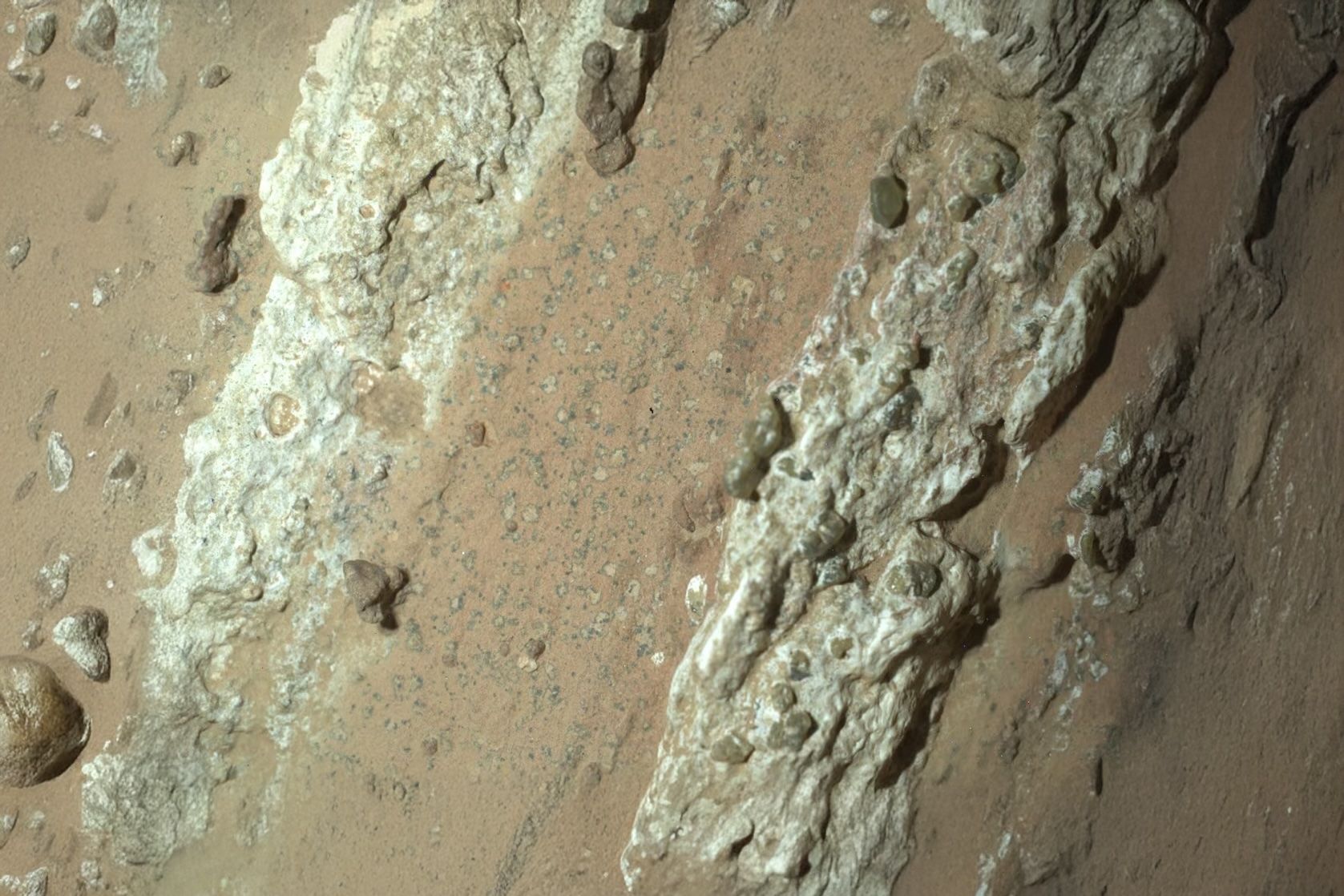- Intriguing Martian Rock: NASA’s Perseverance rover discovered a reddish mudstone rock in Mars’ Jezero Crater with unusual “leopard spot” and “poppy seed” patterns on its surface [1] [2]. The rock, nicknamed “Cheyava Falls,” was found along an ancient river valley (Neretva Vallis) that fed a lake in the crater billions of years ago [3] [4].
- Potential Biosignature: Scientists say the rock’s speckles are made of two minerals – vivianite (blue-green iron phosphate) and greigite (brown iron sulfide) – plus organic compounds, all found tightly packed in the sediment [5] [6]. On Earth, these minerals typically form when microbes digest organic matter and leave mineral byproducts, making this “the clearest sign of life that we’ve ever found on Mars,”according to acting NASA administrator Sean Duffy [7] [8]. The features are being deemed a “potential biosignature,” meaning they could have a biological origin [9] [10].
- Not Proof of Life (Yet): NASA officials stress they have not discovered living organisms or definitive proof of past life – “It’s not life itself,” notes Nicky Fox, head of NASA’s science directorate [11]. Similar mineral patterns can form without life through certain geochemical reactions, so researchers say further study is needed before concluding Mars had microbes [12] [13]. For now, the team is cautiously excited: “We cannot claim this is more than a potential biosignature… we cannot rule out [non-biological] processes completely on the basis of rover data alone,” lead scientist Joel Hurowitz explains [14].
- Year of Analysis & Peer Review: Perseverance drilled and collected this sample (dubbed “Sapphire Canyon”) in July 2024, but NASA held off declaring its significance until extensive analysis was done [15] [16]. Over the past year, scientists scrutinized the rover’s data and prepared a peer-reviewed study. “After a year of review…we can’t find another explanation” for the rock’s features, Duffy said at a press conference Wednesday, announcing the Nature journal publication [17] [18]. The rigorous process, including Nature peer review [19], was meant to ensure the findings were solid before exciting the public about possible life on Mars.
- Next Steps – Bringing Samples Home: To know for sure if ancient microbes were involved, scientists say they need to analyze Mars rocks in Earth labs [20] [21]. Perseverance has sealed the precious “Sapphire Canyon” core in a titanium tube, intended for a future Mars Sample Return mission [22]. However, that mission’s fate is uncertain – the current U.S. budget proposal would cancel it, and NASA is now exploring alternative ways to retrieve or further study the samples on Mars [23] [24]. “We’re looking at how we get the sample back… how do we spend money better, and what technology do we have to get samples back more quickly?” Duffy said, acknowledging the funding challenges [25].
A Mysterious Rock in an Ancient Martian Riverbed
NASA’s Perseverance rover, which landed in Jezero Crater in 2021, has been on the hunt for signs of past life. In an ancient river channel called Neretva Vallis – once a conduit for water into Jezero’s lake – the rover spotted something unusual last year [26] [27]. A flat, fine-grained mudstone rock caught scientists’ attention because its surface was dotted with multicolored spots and tiny nodules. The science team nicknamed the rock “Cheyava Falls,” after a waterfall in the Grand Canyon, due to its shape. They playfully described the larger blotches as “leopard spots” and the tiny dark bumps as “poppy seeds” [28] [29].
This rock was part of a layered outcrop called the Bright Angel formation, on the northern edge of Neretva Vallis [30] [31]. Perseverance drilled a core sample from Cheyava Falls in July 2024 and sealed it in a tube, labeling it “Sapphire Canyon.” Even from the rover’s cameras, the distinctive mottled pattern on the core was visible, hinting that something interesting happened as it formed [32] [33].
At the time of collection, the mission team immediately recognized “it was exactly the type of rock they were hoping to find,” according to NASA’s Katie Stack Morgan [34]. Cheyava Falls lies in what was once a muddy lake-bottom environment over 3 billion years ago, a prime location to preserve evidence of any life that might have existed when Mars was warmer and wetter [35] [36]. The rover’s instruments went to work, examining the rock’s chemistry and mineralogy to decode the story behind those leopard-like spots.
Chemical Clues: Organics and “Microbe Minerals”
Analyzing Cheyava Falls, Perseverance made multiple converging discoveries. First, its SHERLOC instrument (which uses Raman spectroscopy and fluorescence) detected organic molecules in the rock [37]. Organics – carbon-based compounds – are the fundamental building blocks of life as we know it. Finding them in Martian rocks is always intriguing, though organics can also come from non-biological sources like meteorites. In this case, the organic material was found mingled with minerals in the mudstone.
Even more striking were the mineral deposits forming the “spots.” Using its X-ray spectrometer PIXL, Perseverance found the dark round spots are rich in iron, phosphorus, and sulfur compounds [38]. Scientists identified two specific minerals: vivianite (an iron-phosphate that is blue-green) and greigite (an iron-sulfide that appears brown) [39] [40]. On Earth, these exact minerals often form together when microbes are feasting on decaying organic matter in wet sediments [41] [42]. As lead author Dr. Joel Hurowitz explains, “On Earth, reactions like these – which combine organic matter and chemical compounds in mud to form new minerals like vivianite and greigite – are often driven by the activity of microbes” [43]. In essence, microbes in mud can “eat” the organic carbon for energy and excrete or precipitate new minerals as a byproduct of their metabolism [44].
The context of the rock’s formation supports this scenario. Scientists think that long ago, mud and organic debris settled to the bottom of a calm lake in Jezero, eventually hardening into rock [45] [46]. Later, water likely percolated through cracks, leaving behind white veins of calcium sulfate (a sign that water flowed there) and altering the rock’s chemistry [47] [48]. This water-driven alteration could have caused iron-rich red minerals (like hematite, which gives Mars its red color) to change and redistribute, possibly “turning the rock from red to white” in streaks and creating black-ringed spots in the process [49]. Crucially, those kinds of chemical reactions – involving iron, sulfur, phosphorus, water, and organics – would have released energy that could sustain microbes if any were present [50] [51].
The presence of organic carbon alongside those minerals is what elevates this find. As Hurowitz noted, Perseverance confirmed the rock is “rich in organic carbon, sulfur, phosphorus and iron (in its oxidized form, rust)” – essentially a buffet of ingredients on which simple life could thrive [52]. And nestled in that buffet are the telltale vivianite and greigite clusters, the possible metabolic “leftovers” of ancient microbes [53]. It’s the strongest hint yet that Mars’ geology and chemistry bear the fingerprints of past biology.
“Potential Biosignature” – Excitement Tempered by Caution
Researchers are calling these intriguing mineral-and-organic features a “potential biosignature” [54] [55]. In astrobiology terms, a potential biosignature is something that might have a biological origin but isn’t conclusive without further evidence [56]. Importantly, NASA is not claiming proof of life on Mars at this stage. “It’s a signature… It’s not life itself,” clarified Dr. Nicky Fox of NASA, emphasizing that even if this came from life, it would have been “something that was there billions of years ago, nothing that’s currently there” [57].
The scientific team took one year to double-check every non-biological explanation they could think of. Other processes, like purely chemical reactions in mud or heating of sediments, can sometimes produce similar mineral patterns without biology. For instance, certain inorganic reactions could conceivably generate vivianite and greigite given the right conditions of water chemistry and redox conditions, even in a sterile environment [58]. “There are chemical processes that can cause similar reactions in the absence of biology, and we cannot rule those processes out completely on the basis of rover data alone,” Hurowitz cautioned in the press briefing [59]. Because Perseverance’s instruments, while advanced, cannot provide a definitive test for life (such as detecting cellular structures or complex organic biomarkers), the results must remain suggestive rather than proof.
Despite the caution, the discovery has stirred optimism in the Mars research community. Sean Duffy, NASA’s acting administrator, said scientists spent months on rigorous analysis and ultimately concluded “we can’t find another explanation, so this very well could be the clearest sign of life that we’ve ever found on Mars – which is incredibly exciting” [60]. In other words, life is a compelling interpretation for these findings because simpler explanations have fallen short so far. Dr. Nicky Fox put it in big-picture terms: “Today, we are really showing you how we are kind of one step closer to answering one of humanity’s most profound questions, and that is, are we truly alone in the universe?* [61].
Outside experts agree this is a significant clue. “These rocks are prime targets in the search for ancient life on Mars,”said geochemist Nicolas Dauphas, noting that only by bringing them to Earth can we answer the “billion-dollar question: ‘Was there ever life on Mars?’” [62]. And in a commentary on the new study, planetary scientists Janice Bishop and Mario Parente pointed out that if microbes ever lived in Mars’ old lake, you’d expect to see exactly what Perseverance found: microbes could have “reduced sulfate minerals to form sulfides in such a lake” just as the rock’s chemistry suggests [63]. In short, the discovery aligns with what scientists theorize Martian microbial life would produce – if it existed.
What’s Next: Confirming Life Will Take More Than a Rover
The Perseverance rover has a limited toolkit. It can detect interesting chemistry and cache samples, but it cannot directly confirm ancient life – for example, by spotting microscopic fossils or performing exhaustive laboratory tests on the samples. NASA’s plan has always been to bring Perseverance’s samples back to Earth in a future mission, so that labs around the world can apply far more powerful instruments to hunt for signs of life (such as microbial cell structures, complex organic molecules, or isotopic signatures of biological processes). This ambitious Mars Sample Return mission was intended to launch later this decade.
However, as of now, the sample return effort is in limbo. In 2023, facing cost overruns, NASA scaled back planning for the mission to a “bare-bones” approach [64]. And earlier this year, the White House proposed steep cuts to NASA’s science budget that would effectively cancel the Mars Sample Return program, deeming it too expensive [65]. “It’s currently unclear how NASA would return the samples to Earth as the agency grapples with [a] proposal to slash NASA’s science budget by as much as half,” CNN reported [66].
NASA leadership says they are evaluating alternatives to get the job done. Sean Duffy declined to commit to a specific plan for retrieving the rocks but indicated NASA is in active discussions on the issue [67]. “We’re looking at how we get this sample back, or other samples back… We’re going to look at our timing, and how do we spend money better, and what technology do we have to get samples back more quickly?” Duffy explained [68]. One idea is to develop new techniques to analyze the samples remotely on Mars using advanced instruments, if bringing them home proves too difficult. Another idea is partnering with commercial or international agencies to share the burden of a return mission [69] [70].
In the meantime, the science team isn’t idle. Researchers are already planning laboratory experiments on Earth to try replicating the Martian rock’s features under controlled conditions [71]. By simulating the ancient Martian lake environment with and without microbes, they hope to see if the unique combination of vivianite, greigite, and organics can arise purely chemically. Field studies at Earth locations with similar geology (e.g. ancient lakebeds with iron and sulfur minerals) are also on the agenda [72]. These studies could help determine whether Mars “nature” could mimic life’s signature, or if biology is the more likely explanation for Cheyava Falls’ leopard spots. As Dr. Hurowitz put it, the goal is to figure out “whether nature has conspired to present features that mimic the activity of life”or if we’re seeing true biosignatures [73].
Every new bit of data moves us closer to an answer. Perseverance will continue roving Jezero Crater, examining other rocks – especially in the ancient river delta nearby – for additional evidence of past life. With each discovery, scientists refine their targets and strategies. NASA’s Nicky Fox emphasized the importance of sustained exploration, saying “NASA science discoveries do not just happen at random. They are the result of meticulous, long-term strategic planning… Each new discovery helps drive what research comes next.” [74]. The Martian “leopard spot” rock has now become a prime example of that cycle: it was the product of years of planning (from choosing Jezero Crater as a landing site to developing life-detection instruments), and its tantalizing results are already influencing the next steps in the search for life beyond Earth.
In summary, a humble rock on Mars, peppered with strange spots, has given scientists perhaps the best hint yet that life may have once existed on the Red Planet. It’s a story of patient exploration – rover geologists carefully reading clues in stone – and a reminder that big discoveries in science often unfold gradually. We now have a candidate biosignature on Mars that begs for confirmation. If future investigations prove that those leopard spots were indeed formed by Martian microbes, it would answer an age-old question and make history. For now, though, the tantalizing evidence rests sealed in a rover’s sample tube, waiting for the day we can finally open it up on Earth and learn its truth.
Sources:
- Kasha Patel, The Washington Post – “NASA discovers ‘clearest sign of life that we’ve ever found on Mars’” (10 Sep 2025) [75] [76]
- Will Dunham, Reuters – “NASA rover finds potential sign of ancient life in Martian rocks” (10 Sep 2025) [77] [78]
- Ashley Strickland, CNN (via RNZ) – “Martian rock contains ‘clearest sign’ yet of ancient life on Mars, NASA says” (10 Sep 2025) [79] [80]
- Ian Sample & Richard Luscombe, The Guardian – “Unusual compounds in rocks on Mars may be sign of ancient microbial life” (11 Sep 2025) [81] [82]
- Joel A. Hurowitz et al., Nature – “Redox-driven mineral and organic associations in Jezero Crater, Mars” (10 Sep 2025) [83] [84]
References
1. www.washingtonpost.com, 2. www.rnz.co.nz, 3. www.washingtonpost.com, 4. www.rnz.co.nz, 5. www.washingtonpost.com, 6. www.reuters.com, 7. www.washingtonpost.com, 8. www.reuters.com, 9. www.washingtonpost.com, 10. www.theguardian.com, 11. www.theguardian.com, 12. www.reuters.com, 13. www.theguardian.com, 14. www.theguardian.com, 15. www.reuters.com, 16. www.rnz.co.nz, 17. www.rnz.co.nz, 18. www.reuters.com, 19. www.rnz.co.nz, 20. www.washingtonpost.com, 21. www.theguardian.com, 22. www.reuters.com, 23. www.reuters.com, 24. www.rnz.co.nz, 25. www.rnz.co.nz, 26. www.washingtonpost.com, 27. www.theguardian.com, 28. www.washingtonpost.com, 29. www.rnz.co.nz, 30. www.reuters.com, 31. www.theguardian.com, 32. www.reuters.com, 33. www.rnz.co.nz, 34. www.rnz.co.nz, 35. www.reuters.com, 36. www.rnz.co.nz, 37. www.rnz.co.nz, 38. www.rnz.co.nz, 39. www.washingtonpost.com, 40. www.theguardian.com, 41. www.washingtonpost.com, 42. www.theguardian.com, 43. www.theguardian.com, 44. www.reuters.com, 45. www.washingtonpost.com, 46. www.rnz.co.nz, 47. www.rnz.co.nz, 48. www.rnz.co.nz, 49. www.rnz.co.nz, 50. www.rnz.co.nz, 51. www.reuters.com, 52. www.reuters.com, 53. www.theguardian.com, 54. www.washingtonpost.com, 55. www.theguardian.com, 56. www.reuters.com, 57. www.theguardian.com, 58. www.theguardian.com, 59. www.theguardian.com, 60. www.reuters.com, 61. www.rnz.co.nz, 62. www.washingtonpost.com, 63. www.theguardian.com, 64. www.washingtonpost.com, 65. www.theguardian.com, 66. www.rnz.co.nz, 67. www.theguardian.com, 68. www.rnz.co.nz, 69. www.washingtonpost.com, 70. www.reuters.com, 71. www.theguardian.com, 72. www.theguardian.com, 73. www.reuters.com, 74. www.theguardian.com, 75. www.washingtonpost.com, 76. www.washingtonpost.com, 77. www.reuters.com, 78. www.reuters.com, 79. www.rnz.co.nz, 80. www.rnz.co.nz, 81. www.theguardian.com, 82. www.theguardian.com, 83. www.theguardian.com, 84. www.theguardian.com










